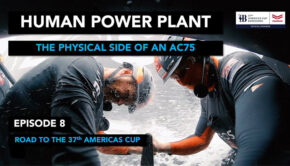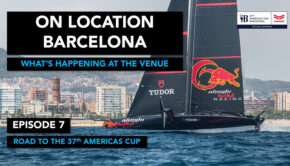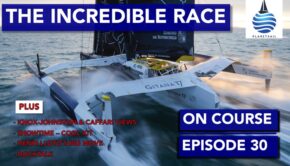Monohull Racing’s Extreme Machine
Published on June 27th, 2018
Extreme sailing doesn’t get much rawer or more muscular than on board a Maxi 72, the jewel in monohull racing’s crown attracting the most competitive of owners and the crème de la crème of crew. Matthew Sheahan shares this world in Howtospendit.com.
There is nothing quite like a Maxi 72 racing boat in full flight. These are extreme machines that push at the boundaries of design and technology and provide an important trickle-down of innovation and data to many other areas of the sport.
In recent years, Maxi 72 racing has been somewhat eclipsed in the news by the futuristic-looking hydrofoiling catamarans that have contested the America’s Cup – creating the impression that foiling is the only game in town.
But with the next Cup three years away (it will again be a battle of hydrofoil technology), it’s time to remember that foiling remains a highly niche form of racing, played out in comparatively controlled conditions, a world away from the mainstream racing scene where the monohull is king.
And the jewel in monohull racing’s crown is unquestionably the Maxi 72 class. While they are not the largest or fastest boats in racing, Maxi 72s (the name refers to the boats’ 72ft length) are the most technically advanced manually driven monohulls on the water, where sails are hoisted, trimmed and changed using muscle power alone – as opposed to the hydraulic mechanisms that crew members employ on the America’s Cup hydrofoils.
They also have conventional soft sails, unlike the rigid aeroplane wing-like sails adopted by the latest America’s Cup craft. Owned, run and helmed by private individuals, a new Maxi 72 will cost around €5-€6m, with annual running costs of around €2m, where €1m per season is spent by some teams on sails alone.
“A base inventory of sails for a 72 that will get you on the circuit for the season could be around €700,000,” says Paul Westlake, head of global sales at North Sails, the world’s biggest sailmaker. “Some teams operate more like an America’s Cup campaign with budgets closer to $1m a year. Of the six current Maxi 72 teams, two function like mini America’s Cup projects, two try to keep their costs within a strict budget, while the others tread the middle ground.”
Crew are the next most expensive element. Maxi 72s attract some of the most experienced and accomplished professional sailors on the scene – many have multiple World Championship titles or Olympic medals to their names. Others have come straight from the America’s Cup. All are experts in working in a closely coordinated team that sails with its foot flat to the floor. So what is it that draws them to relatively heavy monohulls?
“When you look at what we were doing in the last America’s Cup we were grinding winches, but we were simply providing hydraulic pressure to move pumps to move the appendages on the boat to keep them flying,” says four-time America’s Cup sailor and Land Rover BAR crew member David “Freddie” Carr. “There’s something hands-on about Maxi 72s that reminds you why you fell in love with sailing.”
Although still part of Ben Ainslie’s America’s Cup programme, Carr, like many, is weaving other professional sailing jobs into his busy schedule “Sailing at over 40 knots as part of a small team on a foiling America’s Cup boat is something I will never forget. But to sail on a Maxi 72 with 20 other guys where you need to pull off some big, intricate manoeuvres that require split-second timing and coordination is super-rewarding.”
Steve Hayles is one of the world’s top navigators; he has worked for a wide range of professional campaigns and has been closely involved with 72s for over a decade. “It’s the next tier down from the America’s Cup,” he says. “From a professional crew’s point of view, the level that these boats are campaigned at is a large part of the attraction and one of the key reasons the class has remained so popular over the past 10 years.
“They are hugely powerful, weighing around 16 tonnes, with deep keels that draw 5.4m with a nine-tonne keel bulb on the bottom. It’s what makes them such beautiful boats to sail upwind, yet they’ve still got enough sail area to make them fun to sail downwind. Plus, we’ve taken them offshore and have been successful in events like the Fastnet Race and the Sydney Hobart, so they are extremely versatile all-round boats.”
Whatever owners choose to spend, a season’s racing for most will come down to just three or four events. The overall class trophy involves teams’ best two events from the four available inshore regattas. Their overall result also includes their best position from one of three offshore races comprising the RORC Caribbean 600, the Giraglia Rolex Cup, and the Rolex Middle Sea Race.
Racing alongside a wide range of other boats in some of the world’s classic races means that Maxi 72s have to compete in the real world, rather than the short-format, heavily managed, almost sanitised race course of the America’s Cup.
As a result, the Maxi 72s need to be designed to cope with a variety of wind speeds, wind angles and sea states, all of which provide valuable data in hull and sail design, deck gear, sailing techniques and many other aspects of racing that feed down into the mainstream sailing world.
Even cruising boats are affected: for instance, modern hardware and software systems have improved instrumentation and autopilots. Sail design, performance and longevity have also improved as a result of developments in grand-prix areas of the sport such as the Maxi 72s.
But of course, owners are not driven to spend large sums of money exclusively for the benefit of the rest of the sport. The Maxi 72 class has a strict owner/driver rule and, as many owners will attest, playing such a pivotal role in the heat of battle is what proves so addictive.
“If you want to compete in this class you have to approach it with a mindset that you are entering sailing’s equivalent of Formula One and you’re heading out to race against Hamilton and Alonso – you simply can’t be half-hearted,” says Peter Harrison, owner of Sorcha and CEO of watchmaker Richard Mille’s Europe, Middle East and Africa operations. “Running with the big dogs means learning how to play their game.”
Among those who have a long track record in the class is Proteus owner George Sakellaris, founder, president and CEO of Ameresco, a renewable energy company. He is clear about what attracts him to the class.
“If you organise them well they can do offshore races; they are also very good at windward/leeward and coastal races. I like coastal races a lot, so the mix appeals to me,” he says. “But to succeed in this class is also about the development of new technologies and new sails. Optimising the keel and fin rudder, figuring out the gain and how you can do it better really gets you thinking – it’s not just about the sailing, it’s challenging technologically. And I like technical challenges.”
But so do all the other owners, which has a knock-on effect for administrators. “Running the class can be challenging,” says Andrew McIrvine, secretary general of the International Maxi Association, which runs the Maxi 72 class. “Most of these owners have been very successful, both personally and professionally, and are only interested in winning.
“They spend large sums of money in their quest to succeed, but every now and then you get two or three who spend even bigger sums. They burn the others off on the race course and the class goes flat. The irony is that the disgruntled owners take their boats outside the class rules by modifying them to race under the IRC handicap system and end up racing against the same boats under a different system.”
That some Maxi 72s end up on the outside is a constant issue for class manager Rob Weiland. “Sometimes it’s really difficult for the owners to accept rules. They want to be free to do what they want to do, it’s one of the reasons they got into the class in the first place and yet sometimes it looks like they don’t want a class at all.”
“The class was originally formed back in 2012 when the Mini Maxi class of the day was limited to 72ft overall. But as soon as you make a limit, people push against it. Boats get more and more optimised, the cost goes up and then some decide they don’t want to play and break away. But this is all part of the natural cycle of a modern grand-prix class.”
While the Maxi 72 continues to be appealing for an elite group of passionate owners, there is still a question as to what part the boats and their technology may play in future America’s Cup development. “They might be a similar size to the boats that will race in 2021, but they are two very different machines,” says Westlake. “The trickle-down for the Cup might be in assessing new crew, helping with coaching techniques and developing data analysis methods.”
One thing is clear, when you’re riding on the back of a Maxi 72 doing 25 knots facing a mass of sail and spray ahead, the thought of a similarly proportioned boat doing double that speed but weighing less than half and without a keel drives home the scale and ambition of the next America’s Cup project. But for most participants in the sport, the Maxi 72 looks set to remain the ultimate racing machine.









 We’ll keep your information safe.
We’ll keep your information safe.